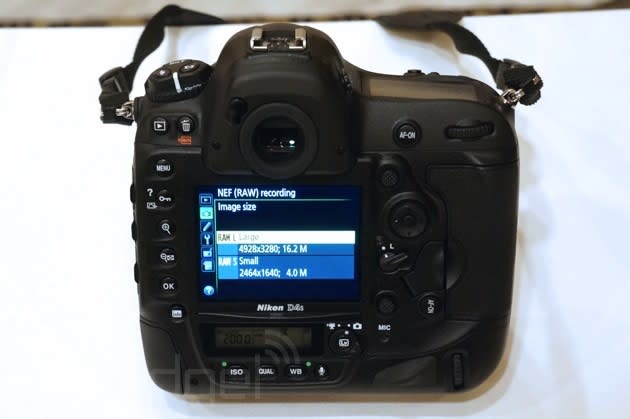Nikon's new D4S DSLR improves speed and focusing, adds ISO settings up to 409,600

The Nikon D4S has been teased, displayed in a plastic case and now, it's official -- and we even got to play with it. There's a substantial list of what hasn't changed (the same 16.2-megapixel image size, to begin with), but if you're a high-level photographer already in possession of a D4 (or perhaps even a D3S), you'll be more interested in those differences. Firstly, while the sensor will offer the same sized images, but it's a newly developed piece of hardware, with a focus on better noise reduction. ISO now ranges from 100 - 25600, with its Hi4 setting cranking that up to a mind-boggling 409600. If you're currently handling a D4, you can also expect to see substantial noise reduction: the D4S' ISO 1600 will be comparable to the D4's ISO 800 setting.
Nikon's new DSLR also delivers changes to to the auto-focus system for both photos and video. Behind the lens, there's improvements to both the tracking system and the algorithms that govern how the D4S focuses. A new Group AF mode tracks five separate points, meaning that a moving subject (and even a moving photographer) should pose less of a threat to crisp imaging. On video, (where you can now capture uncompressed 1080p resolution at 60 frames) tracking has been bumped up to 11 frames per second on full auto-focus and exposure.
Hopefully fixing one of our major issues with the D4, the new model also comes with a more substantial battery pack, up from 2,000mAh to 2,500mAh. The new unit actually weighs more, but reductions on the D4S' body means it adds just seven ounces, total, over 2012's D4. Expect the camera to land on March 6th, and prepare your bank account for the hit: it's expected to retail for $6,500. We've got some early impressions and details on some minor hardware changes, including more substantial grips, right after the jump.

It's still no small thing. As a pro-level camera (it's undeniably for them), the D4S is just as squarish as the models that came before it. However, this also affords plenty of space for buttons, controls and dials: something that it takes full advantage of. Button placement is largely identical to its predecessor, although there are several minor changes aimed at making shooting with the 42-ounce DSLR at least a little more comfortable. Grips for both typical landscape holding, as well as vertical, have been widened and increased in depth. To pull this off without making the camera larger than the D4, Nikon slimmed the body between the main grip and the camera lens, meaning your fingers can dig in deeper and hold on more resolutely -- no-one wants to drop a D4S. On the rear, the sub-selector button has changed from rubber into plastic, a concession made because users felt the rubberized version was slow to respond.
The raised grip here has also been fortified and made more comfortable for bigger hands. Connectivity-wise, there's still an ethernet port (upgraded to 1000 Mbps), audio-out and -in, mini-USB, HDMI and slots for both CF and XQD cards. The D4S can also capture in different RAW file formats (something that rival Canon added to its DSLR camera series several years ago), offering the tweaking benefits of RAW images in a smaller file size. The small RAW option captures at 4MP, compared to the base RAW setting at 16MP, shooting 12-bit uncompressed Nikon NEF files that are roughly half the size of typical RAW shots. Alas, during our time, we weren't able to collect together any early sample images, but the company is apparently putting a lot more effort into how it tackles video on its top DSLRs -- we're now itching to see how it all fares in the field.
Zach Honig contributed to this report.


























